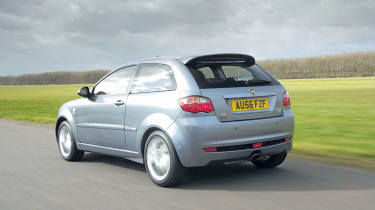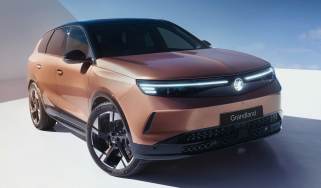Proton Satria Neo 1.6 GSX
With input from Lotus, Malaysian three-door aims to cause a stir
Although it hasn’t been on sale in the UK since 2004, the Satria is
probably the best-known model Proton has ever made – its image
was certainly helped by the 1.8-litre GTi variant. It’s fair to say, however, that the first-generation model hardly set pulses racing – and in terms of styling, the new Satria Neo is little different.
It was penned at the Lotus design centre in Hethel, Norfolk, but there’s not much to get excited about – the Satria’s hatchback shape looks generic alongside its rivals here. Even the ageing Ka has fresher lines.
At least the low stance, flared wheelarches and wide track create a sporty look, but apart from the projector-style lights, there’s nothing memorable about the Proton. True, the low roof gives it a sleek appearance, but unfortunately this also means headroom in the rear seats is severely limited. Legroom is equally tight, and considering it’s the longest car here, that’s a disappointment.
The low roof is an issue up front, too, where the top of the windscreen is almost in line with your head. The Satria feels cramped compared to its rivals, and the driver’s seat doesn’t adjust low enough. Combine this with offset pedals, and the result is an uncomfortable driving position.
Build quality seems fairly solid, but this can’t compensate for the lacklustre plastics on the dash or the flimsy, low-rent air vents. Blue-lit dials on the instrument cluster are an attempt to make things feel more upmarket, yet the heater controls are placed too low down. The cabin is an area in which Proton could really have made an impact, so it’s a shame it’s so dated and cheap.
Things improve slightly with the 1.6-litre CamPro engine, which was also developed in collaboration with Lotus. It’s taken from the Gen2 hatch, and so is the five-speed gearbox, but the Satria has a shorter final drive ratio designed to give better low and medium-speed acceleration. It never feels particularly quick, though, and has to be worked hard to get meaningful performance, while the engine sounds coarse when revved hard. The boomy exhaust helps to provide a sporty edge – something that Proton is clearly aiming for – but on the motorway the drone can become irritating.
Although it’s the most powerful car of this quartet, the Satria was a second slower than the Swift from 0-60mph, at 10.9 seconds. In-gear pace was leisurely, the Proton taking 16.7 seconds to complete the top gear 50-70mph test. A heavy kerbweight and poor gearbox are to blame.
It’s comfortable, however – the ride is fairly refined, while the raked windscreen and smooth shape mean wind noise is minimal. The Satria is also stable at higher speeds, although the suspension does get unsettled by uneven roads.
The Lotus badge on the tailgate promises much in terms of handling, but sadly the Proton doesn’t deliver. While body control is adequate enough, the vague steering and uncommunicative chassis mean it’s neither a rewarding nor enjoyable car to drive. The brakes are also short on feel, and the Satria took the longest distance to come to a halt from 60mph, at 42.1 metres.
Value has always been a selling point for Proton, yet the 1.6 GSX model we tested is the most expensive car here. The Satria is generously equipped, with an MP3 connection, Bluetooth connectivity and rear parking sensors, but it only gets two airbags compared to the six in the Swift. It also has the poorest residuals.
Details
Price: £9,595
Model tested: Proton Satria Neo 1.6 GSX PR
Chart position: 4
WHY: Based on a new platform with input from Lotus, the Satria Neo promises good handling.
Economy
Considering our Satria only had 1,000 miles on the clock, we were impressed with its economy. It returned 38.4mpg, which isn’t far behind the claimed figure of 42.8mpg.
Residuals
Proton is an unknown quantity for most used buyers, so resale values are poor. The Satria keeps 37.3 per cent of its list price, and after three years will be worth £3,579.
Servicing
With the first three services coming to £438, the Proton is the cheapest car to maintain. Yet the 9,000-mile intervals are shorter than for either the Ford or the Hyundai.
Tax
Despite having the largest engine, the Satria isn’t as dirty as the Swift. However, it’s in the same 18 per cent tax bracket. Owners in the lower band face a bill of £380.



